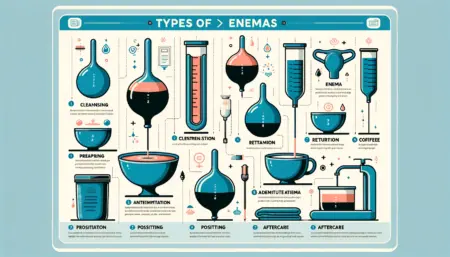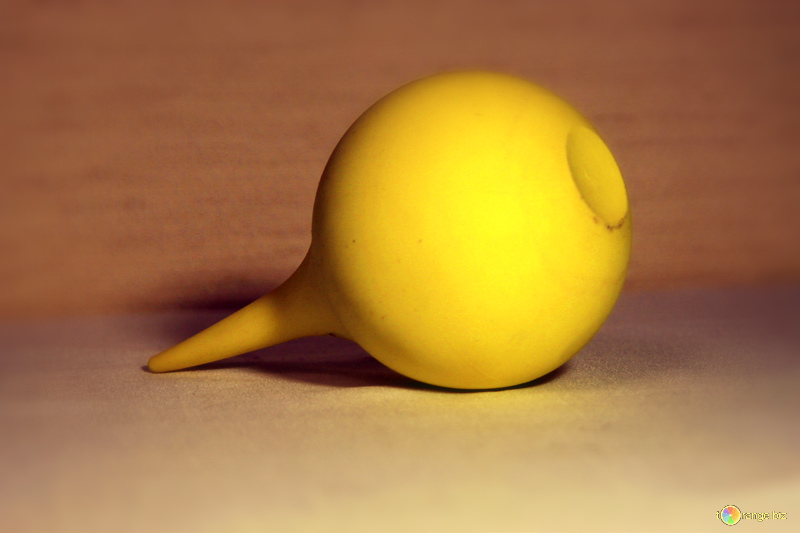Types of Enema are being discussed in this article.An enema is the introduction of fluid into rectum mostly either to empty lower bowel or to introduce a medicinal substance for its general or local effect or for diagnostic purpose.

- Non retention enema or evacuate enema or expelling enema.
- Retention enema.
- Non retention or evacuate enema
- Purgative enema.
- Cleansing enema.
- Cold water enema
Purgative Enema
Soap and compound enema are used as purgative enema for causing of evacuation of faeces and gas of large bowel. The other purpose of purgative enema is to soften fecal matter and to stimulate the colon by heat and chemicals.
Material Required
- Large tray. 2. Enema can with rubber tubing. 3. Rectal catheter or hard rubber nozzle with stop cock or clamping device. 4. Bath thermometer. 5. Solution of soap or disposable enema solution packet. 6. Lubricant solution or vaseline. 7. Towel 8. Bowl. 9. Enema stand. 10. Bedpan with cover. 11. Bedside screen. 12. Jug or ounce measure and wooden spatula. 13. Bowl.of cotton swabs. 14. Forcep. 15. Paper bag. 16. Small piece of paper or rubber square.
Solution
Soft soap 1 ounce in 20 ounces of water.
Procedure
- Inform the patient about the procedure you are going to do.
- Put bed side screen for privacy.
- Attach rubber tube with enema—can with nozzle and stopcock or clamp.
- Place the patient in left lateral position.
- Fill the enema can with 1000 cc of soap solution or saline solution at 107°F (41.6°C).
- Lubricate the nozzle with vaseline or glycerine or liquid paraffin.
- Now hang the can about 18′ (45 cm) from bed or 12″ (30 cm) from patient, on the stand or hold it by hand if stand is not available.
- Place a piece of macintosh under butter of patient to prevent soaking of bed linen from any leakage of fluid.
- Draw the patient at edge of the bed in left lateral position with upper knee slightly flexed.
- Expose the anus.
- Make the tube air free by releasing the clamp and allowing the fluid to run down little to the bed pan and now again clamp it.
- Separate the buttock with left hand to expose the anus. Insert 3*4 inches of nozzle or rectal catheter slowly and gently. Release the clamp to allow the solution to run in.
- Instruct the patient to take deep breath. This relaxes the abdominal muscles.
- If there is desire to defecate as soon as the fluid goes in, decrease the height of the enema can.
- Do not allow all the fluid to go as there is possibility of air entering the rectum.
- Remove the tube gently and put in kidney tray.
- Place the bedpan under patient’s buttock slightly raising the head end of the bed.
- Clean and boil tubing and keep tidy in proper place.
- Remove bedpan and clean the anal area if the patient cannot do by himself.
- The procedure for giving a bed pan should be followed.
- Record the procedure in chart with date and time.
- Note in your notebook regarding any gross abnormality.
- The TPR may also be recorded along with general condition after the procedure is completed.
- If there is failure of enema and no fecal matter comes out, this fact should also be intimated to senior staff.
Types of Enema Are Very Important For Nurses And Everyone,Where you can Know How To Do Enema Without A kit
Compound Enema
This is also known as purgative enema. Here the enema solution is different. The solution is composed of magnesium sulphate 1 qz. (50%), glycerin 2 oz and water 3 oz. The other materials required for enema are the same as mentioned earlier for soap enema.
Procedure
- Measure and pour 1 oz of magnesium sulphate in measuring cup.
- Add 2 oz of glycerine and pour 3 oz of water.
- Heat it to a temperature of 105°F (40.5°C).
- Now procedure is followed as giving the soap water enema.
- After the procedure the bath thermometer is cleaned with detergent solution.
Cleaning Enema or rectal wash out of rectal lavage
This procedure is carried out to ensure that lower colon and rectum are free from fecal matter. This is done prior to rectal operation or before giving a retention enema. The enema solution used may be normal saline 600- lOOO cc. or plain tap water 1000 to 1200 cc. It is necessary to measure the wash out fluid before it is given and also to measure the returned fluid to make sure that no fluid has been left in bowel.
Retention Enema
Retention enemas are enemas meant for various purpose in which the fluid usually a medicine is retained in rectum for short or long period. In mast cases the substance is allowed for retention either for local or general effect.
Types of Retention Enema
i. Short Retention Enema, ii. Long Retention Enema
Principal of Retention Enema
- Retention enema is given slowly by means of a rectal catheter and funnel.
- The amount of fluid is usually 6 to 8 oz or 150-200 cc.
- Before giving this enema the rectum is made free from fecal matter by giving a cleansing enema, cleansing enema is further given after retention time is over to clean the rectum. The temperature of enema fluid is usually at 99°F (37.4°C) or body temperature except stimulating enema which is given at 107F° to 110°F.
Material Required
- Tray. 2. Funnel with tube and stop cock. 3. Kidney tray. 4. Lubricant solution or vaseline. 5. Ounce measure. 6. Bath thermometer. 7. Makintosh. 8. Bed Pan. 9. Bed side screen for privacy. 10. Pint measure. 11. Bowl. 12. A big kidney tray. 13. Forcep. 14. Paper bag. 15. Cotton swabs or wiping cloth or paper.
Short Retention Enema
- Oil retention enema.
- Anti spasmodic enema.
- Carminative and Antispasmodic enema.
Oil Retention Enema
This is used to soften hard and dry stool after operation over abdomen or perineum, when the patient is required to evacuate the rectum mucosa. After a short retention of oil the fecal matter comes out easily without extra stress by patient. In this type 6-8 ounces of sweet or cottonseed oil is used. Never use mustard oft for this purpose as it is an irritant to mucosa. The oil is retained for half an hour. After the time interval of giving the enema either the patient passes the feces by himself or a soap water enema is given to remove the soften stool.
Carminative or Antispasmodic Enema
This is done for purpose of relieving distention and spasmodic pain or discomfort in large gut. The enema fluid consists of either a combination of milk and molasses or soap solution with turpentine oil. Milk 6-8 oz (150-200 cc)with equal amount of molasses are mixed and temperature is brought to 60°C by heating. The solution thus made is used as enema fluid. For other combination 5cc of turpentine oil is mixed with pint of soap water. The procedure of giving enema is as per earlier procedure.
Creating a comprehensive guide to different types of enemas and their procedures in a tabular format requires a careful breakdown of various enema types and the specific steps or procedures associated with each. Here’s a basic outline:
| Type of Enema | Description | Procedure Steps |
|---|---|---|
| 1. Cleansing | Used to relieve constipation or clear the bowel. | – Prepare the solution (usually warm water or saline).<br/>- Lie on your left side.<br/>- Insert the enema tip gently.<br/>- Allow the solution to flow in.<br/>- Hold the solution as long as possible, then expel. |
| 2. Retention | These enemas are held in the bowel for a specific period. | – Prepare the solution (oil, coffee, or medication).<br/>- Lie in a comfortable position.<br/>- Insert the enema tip gently.<br/>- Allow the solution to flow in slowly.<br/>- Retain the solution for the required time, then expel. |
| 3. Coffee | Common in alternative medicine, used for detoxifying. | – Prepare coffee solution and let it cool to body temperature.<br/>- Follow the same steps as a cleansing enema.<br/>- Try to retain the solution for about 15 minutes. |
| 4. Barium | Used in radiology for creating clear images of the colon. | – The procedure is usually done in a hospital.<br/>- A barium solution is introduced into the colon.<br/>- You are asked to move into various positions to coat the colon.<br/>- The solution is then expelled, and X-rays are taken. |
| 5. Saline | A gentle enema, often used for babies and children. | – Use a pre-prepared saline solution.<br/>- The procedure is similar to a cleansing enema, but extra care is taken due to the gentleness required. |
| 6. Mineral Oil | Used to soften stools and ease their passage. | – Warm the mineral oil slightly.<br/>- Follow the procedure for a retention enema.<br/>- Try to retain the solution for at least several hours. |
Conclusion
Understanding the different types of enemas and mastering the enema procedure can be valuable for your health and well-being. Whether you require a cleansing enema, a retention enema, an oil enema, or a mineral enema, each type serves its purpose in promoting colon health. By following the correct enema procedure, you can enjoy the benefits of enemas effectively and safely. So, why not give enemas a try and experience the potential benefits they have to offer
